After dramatically reducing the amount of turf grass we have, we’ve experimented with other options for two general areas:
- the front yard in front of our house, i.e. the traditional area for lawn
- for areas near the road, including the “hellstrip,” i.e. the space between the sidewalk and the road.
For the front yard
We’ve found a number of native plants suitable for a groundcover, though we don’t use just one plant covering the whole front yard. Here’s a sampling:
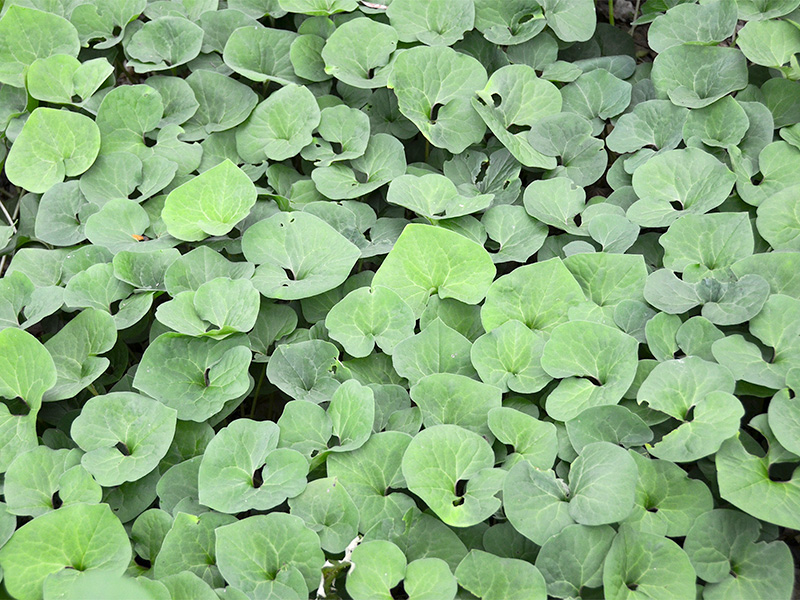
Wild ginger (Asarum canadense) as a ground cover makes a lovely substitute for an area that would otherwise be lawn.
Of course, we wouldn’t be able to walk on it as we would lawn, but people walk on most of their lawn area only when they’re mowing it anyway.
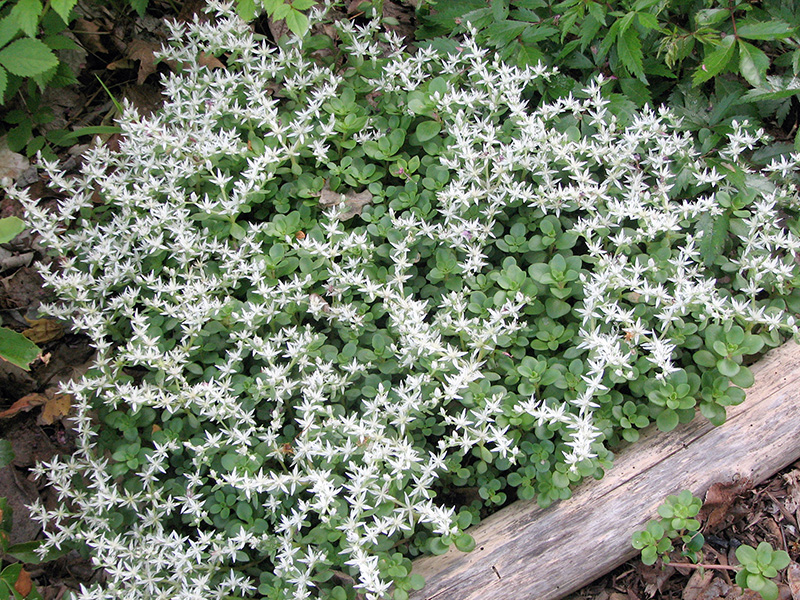
We especially like this native sedum (Sedum ternatum). It’s beautiful when it’s flowering like this, but even after the flowers are gone, this low-growing plant is very attractive and fills in an area. It isn’t aggressive, but it does seem to keep weeds out.
It’s also easy to transplant bits to fill other areas.
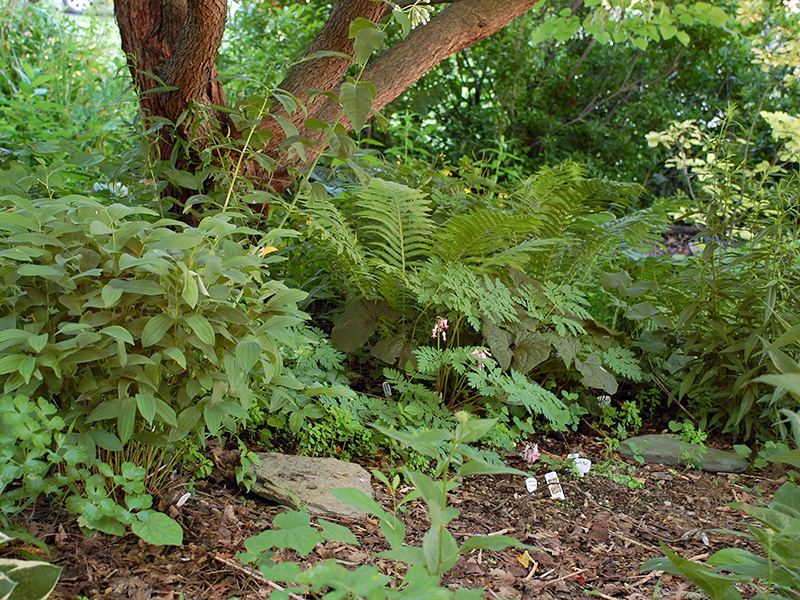
Currently, one of our small woodland areas is beneath the redbud. When this picture was taken, the mayapples, goldenseal, and foamflowers were still fairly new in this area, but they’ve now spread, and the bluebells we started from seed are at blooming size now.
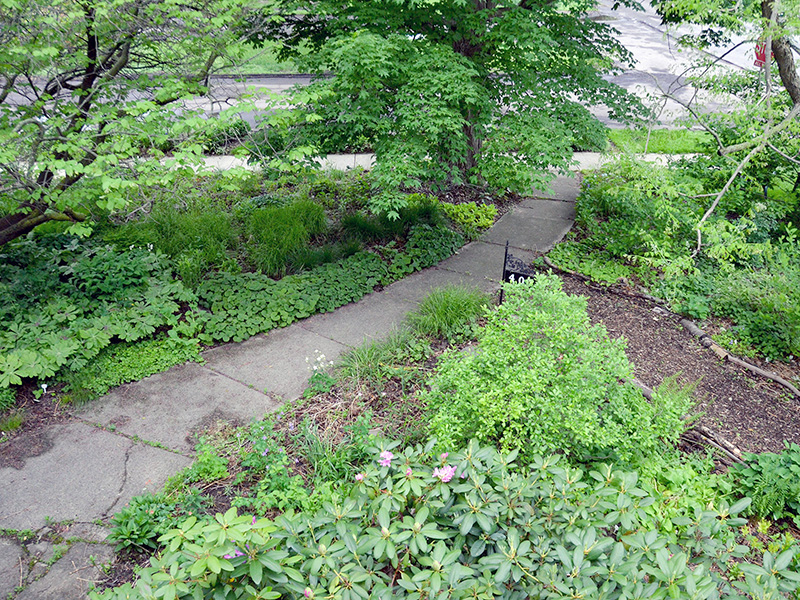
For most of our front yard, though, we’ve simply planted shrubs and perennials.
Lawn substitutes don’t have to be low-growing and uniform!
All in all, we find that we just don’t need so much lawn or lawn-like areas. So many other plants can grow on that land instead. And these plants are so much more enjoyable than just plain lawn.
Where to walk? On the paths!
Bottom line: In our small yard, we want to mainly plant “real” plants, not just have a lawn or lawn substitute.
For areas near the road, including the hellstrip
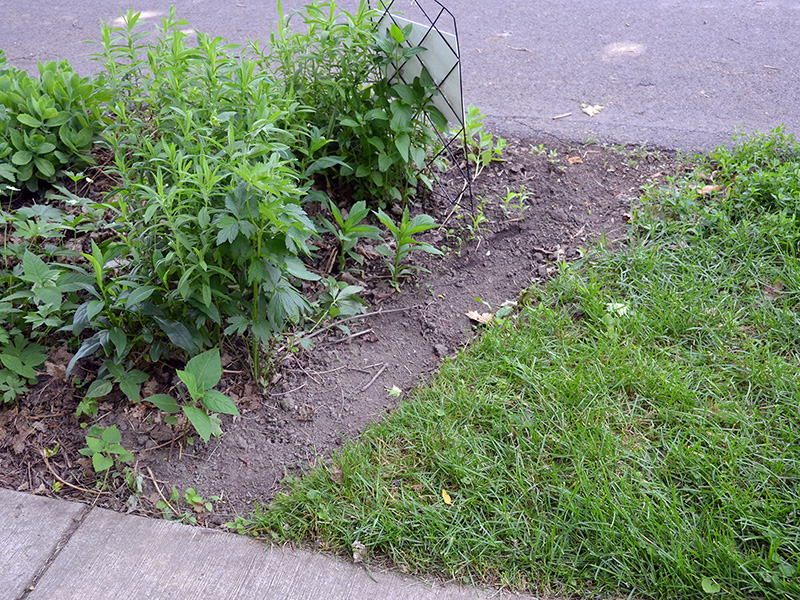
Two major obstacles for us have been:
- Finding plants that are salt-tolerant since the town uses a generous amount of road salt in winter. Most plants don’t like that!
- Finding plants that can grow on top of former road bed, still there at some level after they narrowed (yes, narrowed!) the road a few years ago.
Two major obstacles for us have been:
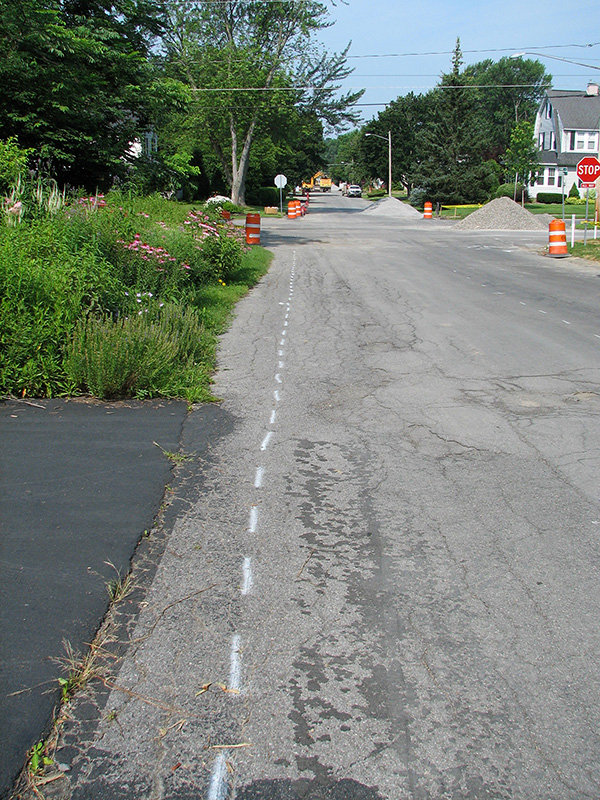
- Finding plants that are salt-tolerant since the town uses a generous amount of road salt in winter. Most plants don’t like that!
- Finding plants that can grow on top of former road bed, still there at some level after they narrowed (yes, narrowed!) the road a few years ago.
The dotted line shows where the road is about to be narrowed — in other words, where we’re now trying to grow some lawn or lawn-like alternatives.
It’s hard to create good growing conditions from road bed!
Below are our experiments for the hellstrip. For the former road bed, we’re settling for some clover and whatever weeds will grow there.
Clover lawn
We tried a Dutch clover white lawn, supposedly popular in Canada. We planted it along the street in a small experimental patch.
One advantage of clover is that it’s nitrogen-fixing, so it doesn’t need to be fertilized. Another advantage is that it provides nectar for bees, if you allow it to get tall enough to flower. (People who don’t want bees can just keep it mowed.)
And clover is a host plant for the clouded sulphur, the alfalfa sulphur, and the Eastern-tailed blue butterflies.
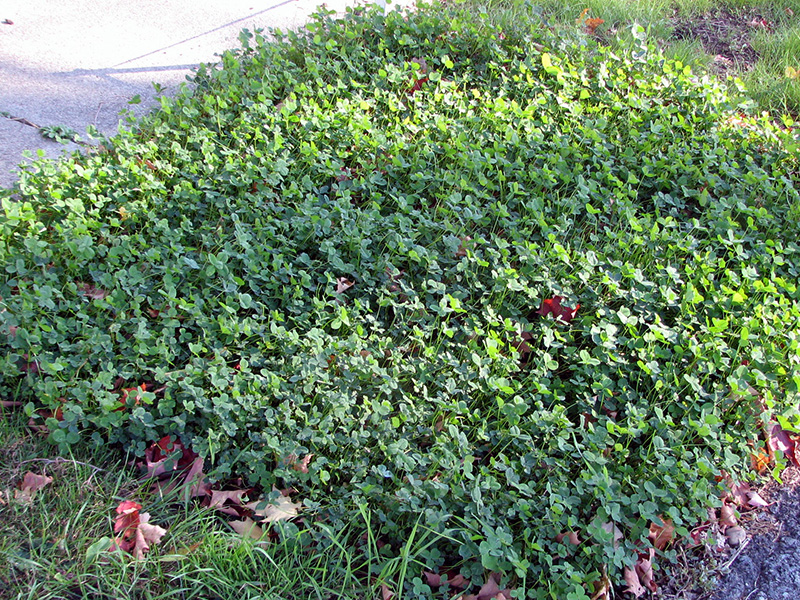
The following year, our formerly thriving clover patch wasn’t very healthy looking. Perhaps, since it borders the road, it got a heavy dose of road salt in the winter. At any rate, we took out that patch and replaced it with No Mow grass for a second experiment.
No Mow lawn
We started out with a small experimental patch of No Mow lawn along our flower bed.
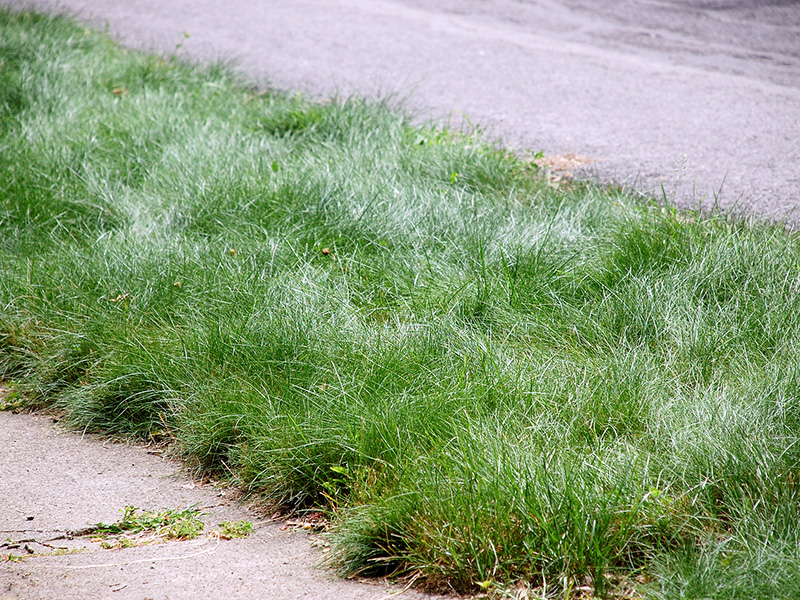
That turned out so well that we converted much of the lawn between the road and sidewalk (the “hellstrip”) to No Mow grass.
It seemed to handle road salt quite well. It’s dark green, fine textured, and doesn’t need to be mowed, fertilized or watered. Though not required, we mowed it once in the spring and once in the fall.
It worked for a while, but since we hadn’t planted it thickly enough, it became infested with weeds, and we’ve since created a flower bed in this hellstrip — altogether a much better use of this land!
We still think a No Mow lawn has potential (especially in an area without road salt) but we’d have to experiment with it a bit more. But we’re now happy the flower bed we created in this hellstrip — altogether a much better use of this land and a wonderful part of a Pollinator Pathway.
Just plants
Just creating a planting bed has worked the best. Here’s more about the hellstrip.
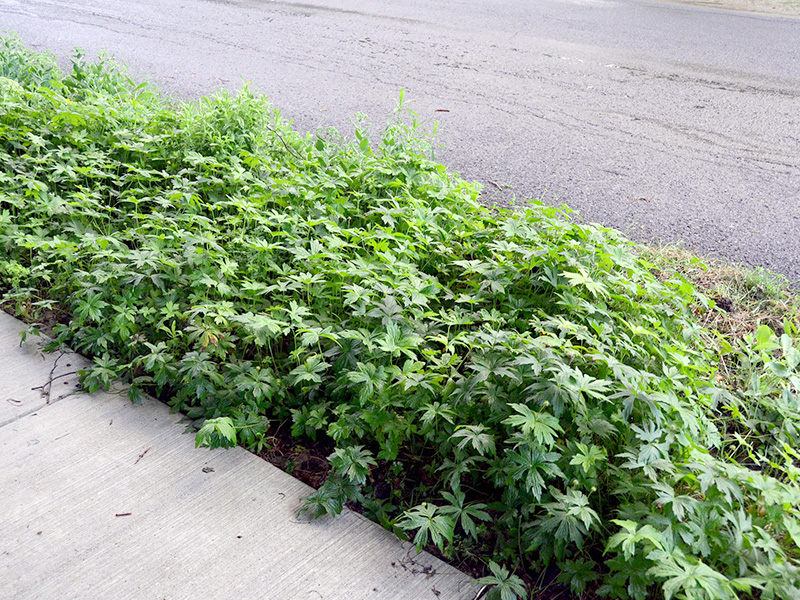
Putting Canada anemones (Anemone canadensis) in the hellstrip solved two problems. It gave me a chance to grow these somewhat aggressive, but beautiful, plants in a place where they would be contained, and it is functioning well in an area that would otherwise be lawn.
UPDATE: We’ve since added a lot of other plants in the hellstrip as the anemones retreated from the road-salty edge. (Here in snowy CNY, road crews use a LOT of road salt, creating a non-native environment.)
Resources
- Amanda’s Native Garden:
- Groundcovers – list of ground covers for sun and for shade
- Choose Natives:
- NY Times:
Native grasses
- Science Daily:
- Lawn of native grasses beats traditional lawn for lushness, weed resistance. Describes research done at the Lady Bird Johnson Wildflower Center
- Ecological Landscape Alliance:
- New Garden at Cornell Plantations Mundy Wildflower Garden by Krissy Boys Faust
- New York Times:
No Mow lawns
- Prairie Nursery:
Clover lawns
- WikiHow:
- Versicolor.ca:
- How to grow a clover lawn – Nova Scotia specifically; same general principles
- EarthEasy:
- Commercial sites:
- LawnStarter: We’re thinking over why we kill clover (a commercial site)
- Scotts: Benefits of planting a clover lawn
Meadows
- Catherine Zimmerman:
- BOOK and VIDEO: The Meadow Project [NOTE: The book has been revised since its 2010 edition.]
- Joe Gardener:
- Owen Wormser
- BOOK: Lawns into Meadows
- Cornell Cooperative Extension:
- Penn State Extension:
- Wild Seed Project (Maine):
- Ecological Landscaping Alliance:
- Joe Gardener:
Moss lawns
- Growing a Greener World 30-minute TV Programs:
- Moss Gardens – Episode 319
- Moss Gardens – Episode 411
- Moss is Boss: To Grow It is to Love It – Episode 614
- Gardening KnowHow:
Reflections
The Future of Natural Landscaping by Neil Diboll
The four largest crops in America, not necessarily in order of total acreage, are: Corn, soybeans, wheat, and lawn. That’s a lot of lawn. And what does it require to maintain all this lawn? Energy and water. It has been calculated that the average American lawn receives four times the volume of chemical applications as an average farm field. And where do these fertilizers, herbicides, fungicides, and the like come from? Most pesticides are derived from petrochemicals. The production of nitrogen and phosphorus fertilizers is extremely energy intensive. Add to that the trucking costs for delivery around the country; and then there is the additional energy cost of hauling away the product of all the fertilizing—the lawn clippings to the landfill or community compost pile. And of course, mowing all that lawn requires a lot of gasoline … The inescapable fact is that we simply will not be able to afford to maintain large expanses of lawn in the future, both economically and environmentally.
As we come to terms with the new realities of limited oil, water, and other resources, it is inevitable that ecologically sustainable landscapes will replace the old, high-maintenance lawns of the past. Perhaps our future status symbols will be based not on how much we consume, but on how little impact we each have on our planet. Instead of measuring success by how large a house we own, or how big a vehicle we drive, social status will be awarded based upon how little of the Earth’s bounty we consume. Maybe, just maybe, we will someday be measured in terms of how much of the world’s resources and natural beauty we preserve for future generations. Now that’s a horizon I can look forward to seeing.
~ Neil Diboll, excerpts from the speech he gave at the 2008 Wild Ones Annual Meeting. Diboll is the founder of Prairie Nursery, the source of our NoMow grass seed
Familiarity is also part of what makes something (or someone) beautiful to us. So landscapes dominated by lawns may feel safe and welcoming if we have grown up with them, and other kinds of landscapes may be less appealing because they don’t feel like home.But as we come to know a place (or person) better, our opinion can change. A wooded landscape may feel oppressive at first if we are used to seeing the sky, but on spending more time among the trees, we may come to appreciate them as havens from the sun and wind, sources of scents that permeate the garden, or nesting places for the songbirds that serenade us each morning. We can grow to love a mossy glade that we can sink our bare feet into, or the soothing of the ocean, or the way the wind ruffles meadow grass, just as we come to adore a friend who always surprises us into a laugh, a neighbor who brings a fresh-baked pie, or a child who reawakens our curiosity about the world.
~ Evelyn Haddon, LessLawn.com
